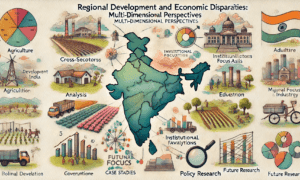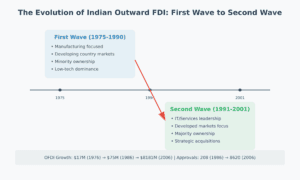The Infrastructure Challenge Imagine you’re a developing country trying to build the basic infrastructure needed for economic growth – roads, power plants, telecommunications. The traditional solution has been to rely on public funding or investment from developed countries. But there’s another fascinating story unfolding – the rise of Indian companies as major infrastructure builders across the developing world.
From Local Champions to Global Players The story begins in the 1960s, when India was building its own engineering and construction capabilities. Through strategic government policies and investments in technical education, Indian companies developed expertise in everything from power plants to railways. By the 1970s, these companies were ready to venture abroad.
Following the Oil Money The first big break came with the 1970s oil boom. As Middle Eastern countries suddenly flush with petrodollars launched massive infrastructure projects, Indian firms spotted an opportunity. They offered quality engineering services at competitive prices, winning major contracts in Iraq, Kuwait, and Libya. A modest beginning of $18.8 million in contracts in 1968-69 grew to billions of dollars.
Evolution of the Model Indian companies’ involvement has evolved in three interesting ways:
- Project Exports: Initially, they simply executed specific infrastructure projects – building roads, bridges, or power plants on contract.
- Direct Investment: Starting in the 1990s, Indian firms began establishing local subsidiaries and joint ventures in host countries. Companies like Tata Communications and Reliance Infocomm invested heavily in telecommunications infrastructure.
- Resource-Infrastructure Swaps: Most recently, innovative deals have emerged where Indian companies build infrastructure in exchange for access to natural resources. For example, ONGC Mittal Energy’s agreement to build railways and power plants in Nigeria in exchange for oil exploration rights.
The Impact The numbers tell a compelling story:
- Indian infrastructure investments in developing countries grew from just $7 million in the 1970s to $1,073 million by 2007
- These investments now span 45 developing countries
- Telecommunications accounts for 38% of investments, followed by construction (29%)
Why It Matters This South-South cooperation creates unique benefits:
- Host countries get quality infrastructure at competitive prices
- Indian companies gain new markets and experience
- Both sides benefit from cultural understanding and similar development contexts
- Projects often focus on smaller contracts overlooked by Western firms
Practical Takeaways
For Businesses:
- Consider the growing opportunities in South-South infrastructure development
- Look for innovative financing models like resource-infrastructure swaps
- Build relationships in emerging markets early
For Policymakers:
- Streamline approval processes for cross-border infrastructure projects
- Develop frameworks to support South-South investment
- Address payment security and contract enforcement issues
This transformation of Indian firms from domestic players to infrastructure builders across the developing world offers important lessons about the changing nature of global development cooperation.
Academic Abstract:
Since 1990s South-South investment flows have assumed a considerable significance in the economic relations among developing countries. The host developing countries tend to see the growing FDI flows from co-developing economies as a prospective source of financial capital, skills and technologies useful for their economic development. However, there is clearly a lack of recognition among them about the potential of southern investment in improving their civil, social and industrial infrastructure. A distinction can be made between the two main forms in which developing country firms participate in the infrastructure sector of co-developing countries. The first is the project exports resorted by southern firms in various infrastructure areas like transportation, communication, energy, etc. The second form comprises direct investment operation of southern firms to provide infrastructure services to the end users. India presents a classic example of South-South investment in infrastructure sector with Indian firms consistently expanding their project exports and infrastructure-related FDI activities over the years. In the light of growing size of Indian project exports and infrastructure FDI, this study calls for evolving a holistic policy framework by both home and host developing countries to enhance the potential of such investment for infrastructure development.
Learn More:
Full citation: Pradhan, Jaya Prakash (2009), ‘South-South Investment in Infrastructure: The Operation of Indian Firms in Developing Countries’, Foreign Trade Review, 43(4), pp.3–31, Publisher: Sage Publications.
Learn More:





































